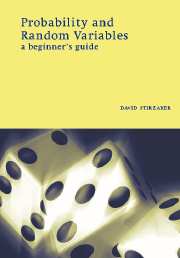5 - Random variables and their distributions
Published online by Cambridge University Press: 05 June 2012
Summary
PREVIEW
It is now clear that for most of the interesting and important problems in probability, the outcomes of the experiment are numerical. And even when this is not so, the outcomes can nevertheless often be represented uniquely by points on the line, or in the plane, or in three or more dimensions. Such representations are called random variables. In the preceding chapter we have actually been studying random variables without using that name for them. Now we develop this idea with new notation and background. There are many reasons for this, but the principal justification is that it makes it much easier to solve practical problems, especially when we need to look at the joint behaviour of several quantities arising from some experiment. There are also important theoretical reasons, which appear later.
In this chapter, therefore, we first define random variables, and introduce some new notation that will be extremely helpful and suggestive of new ideas and results. Then we give many examples and explore their connections with ideas we have already met, such as independence, conditioning, and probability distributions. Finally we look at some new tasks that we can perform with these new techniques.
Prerequisites. We shall use some very elementary ideas from calculus; see the appendix to chapter 4.
INTRODUCTION TO RANDOM VARIABLES
In chapter 4 we looked at experiments in which the outcomes in Ω were numbers; that is to say, Ω ⊆ ℝ or, more generally, Ω ⊆ ℝn.
- Type
- Chapter
- Information
- Probability and Random VariablesA Beginner's Guide, pp. 189 - 237Publisher: Cambridge University PressPrint publication year: 1999
- 1
- Cited by



